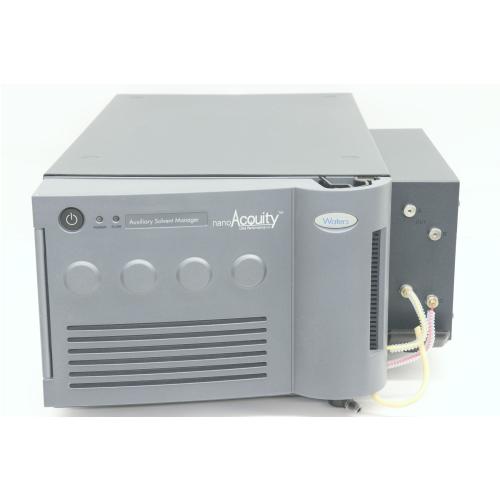The WatersAuxiliary Solvent Manager (ASM) is a solvent management module designed to optimise the chromatographic performance of ACQUITY UPLC M-Class systems. It provides smooth and accurate solvent delivery for column priming and calibration solution addition, with a wide flow range from 0 to 1.0 mL/min (side A) and up to 100 µL/min (side B). Featuring vacuum degassing, i2Valve smart valves and automatic compressibility compensation, the ASM ensures rigorous and automated solvent management in the most demanding UPLC applications.
Auxiliary Solvent Manager Solvent Management Module - Good Condition


Offer Details
Accessories :
38280
Options :
Delivery time between 10-14 working days
Description
Auxiliary Solvent Manager: auxiliary solvent management module for ACQUITY UPLC M-Class systems
The Waters Auxiliary Solvent Manager (ASM) is an essential unit for automated and accurate solvent management in ACQUITY UPLC M-Class chromatography systems. This module is specifically designed to meet the needs of ultra-low flow applications, facilitating column priming (via the A side) and the controlled addition of calibration solutions such as NanoLockSpray™ (via the B side). With two independent channels, it allows for differentiated solvent handling, improving analytical flexibility without compromising flow quality or stability.
The flow rate range offered by the ASM is from 0 to 1.0 mL/min on the A side, intended for pumping solvents for trapping, and from 0 to 100 µL/min on the B side, used for adding calibration solutions. This configuration ensures flow management suitable for nanochromatography or capillary chromatography applications without the need for flow dividers. The system features integrated vacuum degassing with six lines available, enabling bubble-free feeding and increased injection reliability.
The ASM is based on i2Valve smart valve technology for non-return valves, ensuring flow consistency and gradient formation accuracy, even at very low volumes. It also incorporates an automatic compressibility compensation system, eliminating the need for manual intervention, and ensures simplified start-up thanks to a programmable automatic priming system capable of operating at a flow rate of 4 mL/min.
The materials in contact with solvents have been carefully selected to ensure optimal compatibility with a wide range of solvents used in liquid chromatography. These include resistant alloys such as MP35N and titanium, polymers such as PEEK and PPS, and inert components such as sapphire, zirconia and gold.
In addition to its technical features, the ASM fits seamlessly into a modular analytical architecture, providing a functional extension to M-Class UPLC systems. It allows for customisation of analytical methods and adaptation to complex separation protocols. Thanks to its automated features and flow stability-oriented design, it is the solution of choice in environments requiring high reproducibility, increased dosing accuracy and consistent analytical performance.
Features
- Double independent circuit for trapping and adding calibration solution
- Ultra-precise adjustable flow rates for nanoLC applications
- In-line degassing to ensure solvent stability
- Fully automated control and priming
- Seamless integration with ACQUITY UPLC M-Class systems
- Components designed to minimise adsorption and maximise chemical compatibility
Technical Details
- Channel A (trapping pump): 0.0 to 1.0 mL/min
- Channel B (NanoLockSpray™ or calibration solution): 0.0 to 100.0 µL/min
- Solvent conditioning: integrated vacuum degassing (6 lines)
- Primary valves: i2Valve smart valves
- Compressibility compensation: automatic, no user intervention required
- Priming: automatic and programmable; flow rate of 4 mL/min
- Solvent-contact materials: UHMWPE blend, MP35N, titanium alloy, gold, sapphire, ruby, zirconia, DLC, fluoropolymer, fluoroelastomer, PEEK, PPS
Compatible Accessories
- NanoLockSpray™ calibration solutions
- Solvent and elution vials
- Suitable PEEK connectors and tubing
- Control software (MassLynx® or other Waters software console)
- Mounting brackets for integration into chromatography system racks